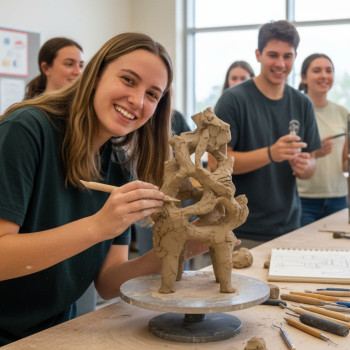Backups & Sync: Never Lose Your AP Notes
There are two kinds of students: those who’ve lost notes and swore never again, and those who haven’t learned that lesson yet. If you’re reading this, welcome to the first camp — or to the right place to change your future. AP classes are intense. We pour weeks into careful notes that capture the difference between a B and a 5. Let’s protect that effort.

Why backing up your AP notes matters more than you think
Notes are not just text. They’re context: the example your teacher drew on the board, your margin annotation that made a confusing concept click, the mnemonic you invented at 2 a.m. When a hard drive dies, your phone gets stolen, or a coffee stain spreads faster than you can blink — those connections vanish.
But loss isn’t only catastrophic; it’s cumulative. Over time, missing or fragmented notes make review inefficient, force re-learning, and add stress during AP season. Backups and sync aren’t just tech chores — they’re study strategies that keep your revision fast, focused, and resilient.
Modern students use multiple devices — that’s both a blessing and a challenge
Tablets for digital ink, laptops for essays, smartphones for quick photo-captures, and notebooks for handwriting. Each has its own strengths. The trouble starts when those devices don’t share the same truth. The goal of a smart backup-and-sync habit is simple: whenever you add or change something, it should be available anywhere you study.
Principles of a reliable backup & sync system
- Redundancy: Keep copies in more than one place. Local + cloud is a solid baseline.
- Automation: Manual backups work until they don’t. Automate syncing so your brain can focus on content, not copying files.
- Versioning: Mistakes happen. The ability to roll back to an earlier version saves time and panic.
- Accessibility: Notes should be searchable and quick to open on any device.
- Security and privacy: Use secure services and, for sensitive content, consider encryption options.
- Simplicity: The more friction in your system, the less likely you are to use it consistently.
Think in layers: Local, Cloud, and External
Build a three-layered approach:
- Local copies — on your laptop or tablet. Fast to access and crucial for offline study.
- Cloud sync — automatic upload to a cloud service. This protects against device loss and allows cross-device access.
- External backup — a weekly snapshot on an external drive or another cloud account for extra redundancy and version snapshots.
Practical workflows for different note-taking styles
Not all students take notes the same way. Below are tailored workflows for three common styles, with concrete steps you can implement tonight.
1) The Paper-First Student
If you love writing by hand but also want digital backups (great for visual memory and exam quick-review):
- Capture with your phone: take a clean, well-lit photo after class.
- Use a scanning app (many phones have built-in scanning in their Notes apps or a free scanner): the app auto-crops, flattens, and creates PDFs.
- Save scans to a designated folder named by course and date (e.g., “APUSH_2025-09-14”).
- Let your cloud service sync that folder automatically, and tag the file with keywords so it’s searchable later.
2) The Digital-Only Note-Taker
Using tablet + stylus or typing directly into a laptop — prioritize sync and version control:
- Use a single note app as your primary hub (consistency beats features).
- Enable automatic cloud sync inside the app and confirm version history is enabled.
- Export weekly snapshots of your notebooks to PDF and store them in a cloud folder labeled by week or unit.
3) The Hybrid Student
Sometimes you type, sometimes you handwrite, sometimes you take jacket-pocket photos. Your system must be flexible and searchable.
- Choose a central repository — e.g., a notes app that accepts uploads and typed notes — and make it your study index.
- Immediately upload any paper scans or voice memos to that repository and tag appropriately.
- Use consistent naming conventions and a weekly tidy-up ritual (see checklist below).
Concrete checklist: a weekly routine that protects your AP year
Routines win. Spend 20–30 minutes each week to keep your system healthy. Here’s a quick checklist to run every Sunday evening.
| Task | Why it matters | Time |
|---|---|---|
| Sync all devices | Ensures recent changes are uploaded and available everywhere | 5 minutes |
| Organize new scans/notes into folders | Makes retrieval during study sessions faster | 5–10 minutes |
| Export backup snapshot | Creates a restore point in case of accidental deletions | 5 minutes |
| Check version history | Confirm you can roll back important files | 2–5 minutes |
| Clear duplicates and tag key pages | Reduces clutter and improves search accuracy | 5 minutes |
Automating the boring stuff
Set up automatic routines where possible:
- Auto-save in your note app.
- Auto-upload camera roll to a private cloud folder when on Wi-Fi.
- Use folder or file naming templates — date first (YYYY-MM-DD) makes chronological search effortless.
Tools & techniques: what to pick and why
There are dozens of apps and services. The exact brand or product matters less than the properties listed earlier: reliability, versioning, accessibility, and simplicity. Here are tool types and how students typically use them.
Cloud Storage (Sync + Backup)
Use cloud storage for cross-device availability and disaster recovery. Keep your active notebooks and scans in a synced folder so they’re always available on phones, tablets, and laptops.
- Store weekly exported PDFs for long-term snapshots.
- Enable two-factor authentication (2FA) for account security.
Note Apps as Hubs
Some students prefer a single app to collect everything: typed notes, handwritten pages, photos, and voice memos. The advantage is consolidated search and a single source of truth.
- Use tags and notebooks to mirror your course structure (e.g., “AP Calc BC > Unit 4”).
- Take advantage of built-in OCR (text recognition) for photos so handwritten notes become searchable.
External Drives and Archived Snapshots
Every semester, make an archive snapshot on an external drive or a second cloud account. This protects against accidental bulk deletions and gives you long-term storage for past classes.
Versioning and File Recovery
Version history is a lifesaver after accidental deletions or overwrites. Make sure your cloud or note app keeps multiple versions and that you know how to restore them.
Searchability: the unsung hero of a notes system
Having everything saved is great — being able to find it fast is better. A search-friendly setup reduces wasted time and makes exam week efficient.
- Use consistent tags and naming conventions (subject, year, unit, date).
- Use OCR for handwritten notes so keywords become searchable.
- Create a short “index” note at the start of each unit summarizing key files and where they live.
Example naming convention
APBio_2025-03-12_LabPhotos_Structures.pdf — clear, sortable, and readable at a glance.
When things go wrong: quick recovery playbook
If you discover missing notes, stay calm. Follow this quick playbook:
- Check the cloud trash/recycle bin first; many services keep deleted files for 30 days or more.
- Look in version history for overwritten files.
- Search by keywords across your synced folders (don’t rely on visual scanning).
- If the device failed, prioritize accessing the cloud copy from another device before troubleshooting hardware.
- If you only have a paper copy left, scan it immediately and add it to the primary repository.
Real-world example
Imagine you’re prepping for the AP US History exam and realize your timeline notes for the Cold War are gone. If your photos auto-uploaded from your phone, you can open another device, find the scanned pages in a “APUSH/2025” folder, and print or review them within minutes. That’s the difference between a frantic two-hour re-creation and a calm focused review session.
Study-focused organization: not just storage, but study flow
Backups are protective; organization is productive. Arrange your notes so study sessions become frictionless.
- Create folders by course, then by unit, then by resource type (notes, slides, homework, practice FRQs).
- Keep a “Review Ready” folder with concise summaries and high-yield sheets for final weeks.
- Use checklists in your repository for what to revise before a practice test.
Table: folder hierarchy example for one AP course
| Level | Example Folder/Name | Content |
|---|---|---|
| Course | AP Calculus BC | All course materials |
| Unit | Unit 4 — Integration Techniques | Lecture notes, example problems |
| Resource | Worked Problems — Integration By Parts.pdf | Exports and scans |
| Study Kit | Unit 4 — 1-Week Review | Summaries, flashcards, key formula sheet |
Collaboration and shared notes
Study groups are powerful, but they introduce additional syncing needs. When sharing notes, do this:
- Create a shared folder with clear rules (naming, who can edit).
- Establish a “final version” file for each topic to prevent multiple conflicting edits.
- Agree on a backup cadence — for group materials, export weekly PDFs so everyone has a stable copy.
Exam season strategies: make backups part of your sprint plan
In the last three weeks before an AP exam, your notes become the fuel for rapid review. Treat them like exam prep assets:
- Build a “Last 21 Days” folder with daily goals and one-page review sheets for each unit.
- Freeze your main notes repository 48–72 hours before the exam (export PDFs so no accidental edits change content).
- Keep a backup on a small external drive or a second cloud account as an insurance policy.
Personalized help and tutoring: when to bring in an expert
Even the best systems need human coaching. If you struggle to organize notes into a study-ready system, or if you want one-on-one help translating your notes into a targeted review plan, consider personalized tutoring. Sparkl’s personalized tutoring offers 1-on-1 guidance, tailored study plans, expert tutors, and AI-driven insights that can help you turn a pile of notes into a winning exam strategy. A tutor can audit your current system, suggest a simpler workflow, and help build the review materials you’ll actually use in the weeks before the AP test.
Common pitfalls and how to avoid them
- Too many apps: Having five note apps fragments your knowledge. Consolidate to one or two and stick with them.
- No naming convention: If files are labeled “IMG_1234.jpg” you’ll waste time hunting. Use meaningful, date-first names.
- No routine: The best system fails if it’s not maintained. Make the weekly 20-minute tidy-up non-negotiable.
- Over-reliance on a single device: Losing a phone should not mean losing months of notes.
Last-minute checklist before the exam
- Export your review folder as PDF and save to an offline-accessible location.
- Ensure key formula sheets and condensed notes are printable or saved on your phone for quick pre-test review.
- Confirm at least one backup exists off your main cloud account (external drive or second cloud).
- Take a deep breath — preparation plus reliable access equals confidence.
Parting advice: systems beat willpower
When AP season gets hectic, willpower fades. A small, repeatable backup and sync system keeps your notes intact without heroic effort. Make automation your default, make labeling a tiny habit, and spend 20 minutes each week to keep everything in order. That small investment multiplies into hours saved and stress avoided during exam time.
And remember: if you want extra help turning your notes into a targeted review plan, or you need 1-on-1 support building a system that fits your learning style, Sparkl’s personalized tutoring can be a practical, focused resource — not just for content, but for study architecture. You built the notes; now protect them so they can do their job when it matters most.

Quick reference: 10-step starter plan (do this in one hour)
- Pick one primary note app and stick with it for the term.
- Create course folders and a “Review Ready” folder.
- Set your phone to auto-upload photos to the course folder over Wi-Fi.
- Enable auto-sync on your tablet/laptop note app.
- Export PDFs of each unit and store them in an “Archive” folder weekly.
- Turn on version history in your cloud account.
- Set a recurring weekly calendar reminder for the 20-minute tidy-up.
- Make a one-page unit summary after each unit ends.
- Create a “Last 21 Days” folder for exam sprint materials.
- If overwhelmed, book a short session with a tutor (personalized support helps streamline everything).
Start today. Back up tonight. Meet your exams with calm confidence knowing your notes — and the insights they hold — are safe, searchable, and ready when you need them.
























No Comments
Leave a comment Cancel